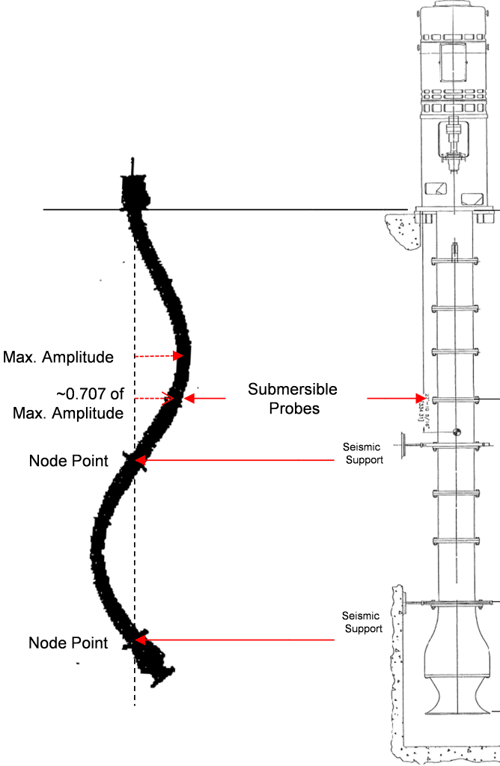Nuclear Service Water Pump Elevated Vibration
Four nuclear Service Water (SW) pumps had been retrofitted to use a modified below-ground structure. After several years of operation, one of the SW pumps experienced vibration at twice normal levels at the below-ground submersible accelerometers. This rotating machinery vibration condition began after the rotating top shaft sleeve was replaced to address excessive top shaft radial motion.
MSI performed specialized vibration testing that included experimental modal analysis (EMA), continuous monitoring, and operating deflection shape (ODS) characterization. EMA involved impacting each pump and measuring the vibratory ring-downs to identify system natural frequencies and characterize their corresponding vibration mode shapes. The continuous monitoring test involved instrumenting the SW pump to study its dynamic behavior under normal operating conditions (overnight testing). Finally, the ODS characterization involved applying steady-state vibration data to a computer model of the system, then animating it at certain vibration frequencies of interest to study the relative motion between components vibration of the motor, discharge head, and below ground column assembly.
ODS animation.
In MSI’s opinion, the high vibration of the below-ground structure of the SW pump was due to a structural resonance of its 1st below-ground “S” shape mode excited by typical rubbing/ impact. This mode was measured to be at 64% of running speed. However, when rubbing/ impact occurs it usually manifests as harmonics of 0.5x rpm or 1/3x rpm. In this particular case, the 2/3x rpm harmonic was exciting the below-ground mode. This change in vibration characteristics was likely caused by potential looseness or wear of the seismic supports (changing the stiffness of the below-ground structure). In addition, it was also possible that the bearings of the below-ground structure are worn due to erosion caused by suspended sand and silt in the lubrication fluid from previous storms.
Since the problematic offending mode represents the 1st bending mode (“S” shape) with maximum vibration amplitude above the permanent submersible accelerometers, the acceleration reported represents approximately 0.707x of the highest vibration in the system. Therefore, MSI recommended appropriate levels for monitoring at the submersible accelerometers and recommended the pump remain in continuous service until the next scheduled outage, at which point the seismic supports should be inspected for potential looseness or wear.
REAL-WORLD EXAMPLES AND CASE STUDIES
MSI In Action
Case Study
A Cure for the Common Cold – in Turbines
A steam turbine at a waste-to-energy facility in the Northeast underwent a scheduled repair, at which time the turbine bearings were reworked, after which the turbine periodically experienced very high amplitude shaft vibrations.
Case Study
BFP Fluid Drive Troubleshooting
A boiler feed pump (BFP) driven off of the main steam turbine via a fluid drive was experiencing high vibration levels leading to frequent replacement of the fluid drive bearings.
Case Study
Aeroderivative Gas Turbine Modifications to Solve a Problem
MSI was contracted to understand and help solve a high vibration problem on an aero-derivative gas turbine driven generator.


